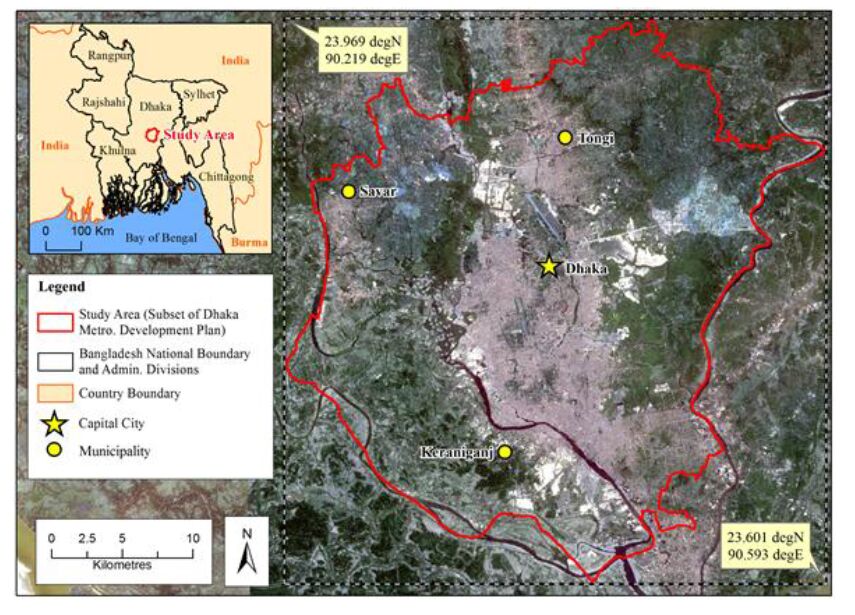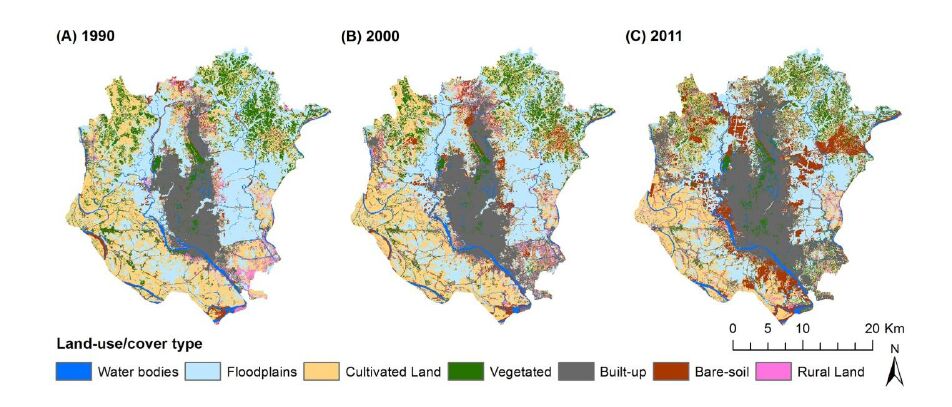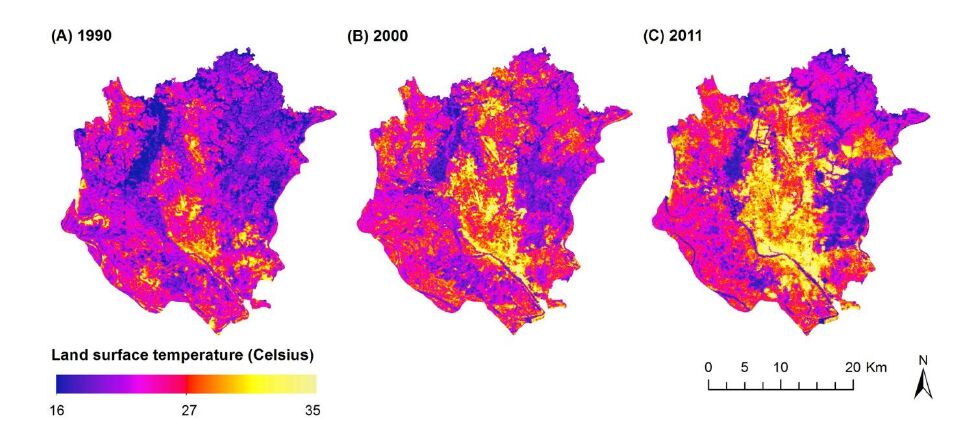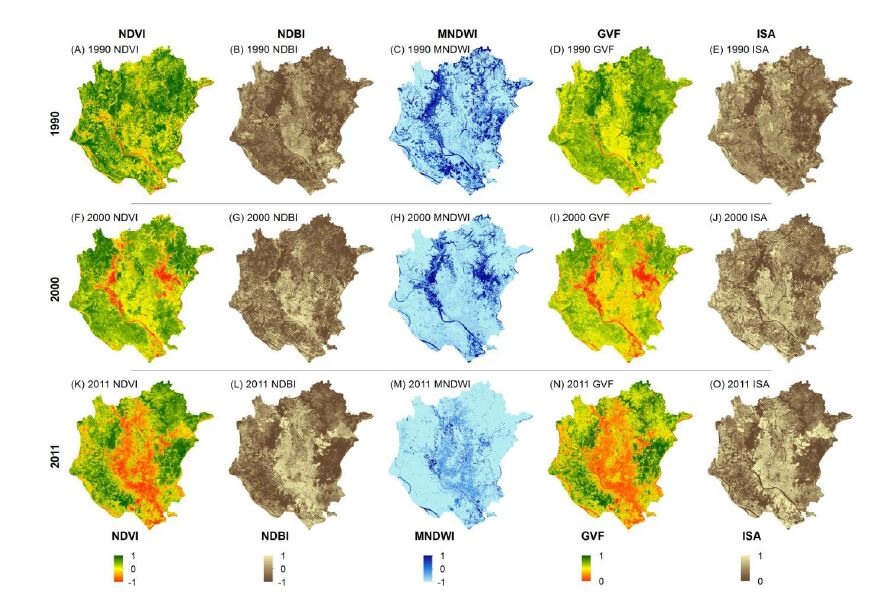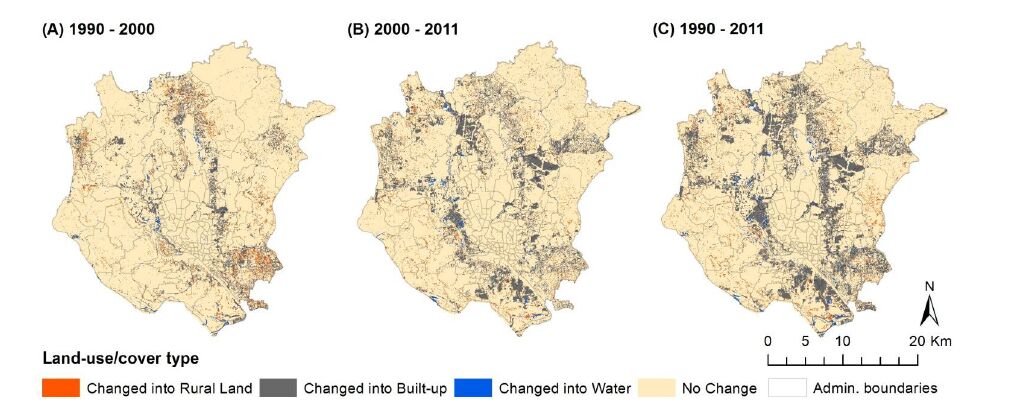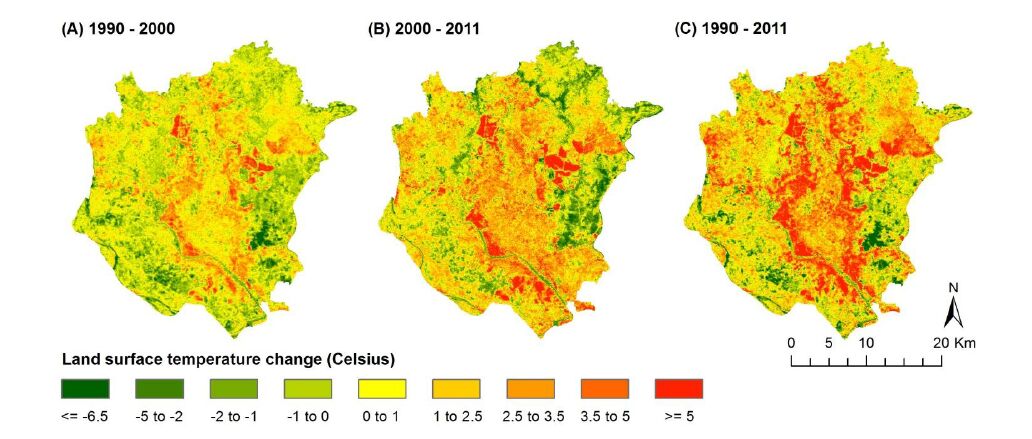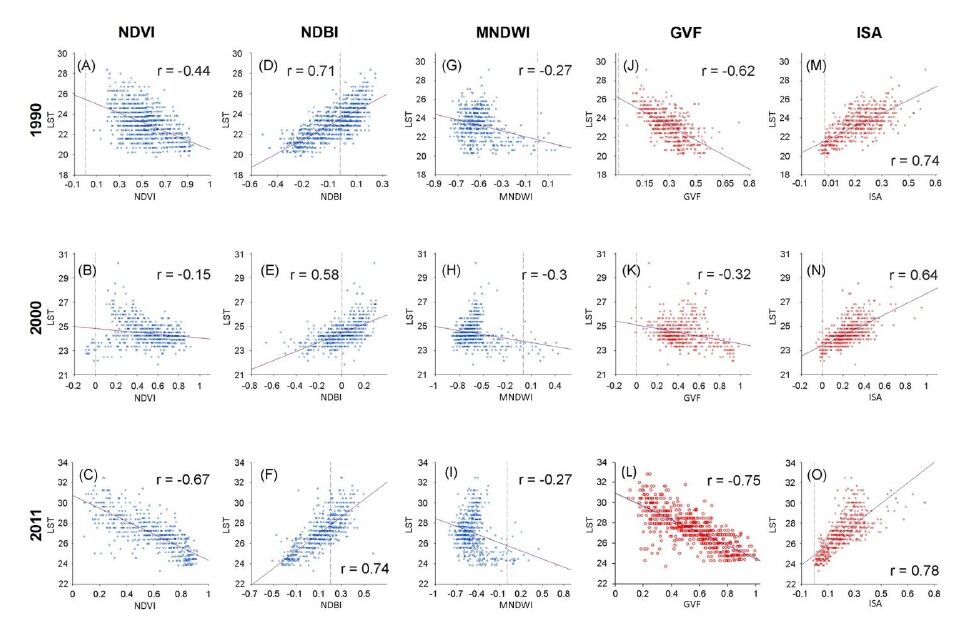This study investigates the influence of land-use/land-cover (LULC) change on land surface temperature (LST) in Dhaka Megacity, Bangladesh during a period of rapid urbanisation. LST was derived from Landsat 5 TM scenes captured in 1990, 2000 and 2011 and compared to contemporaneous LULC maps. We compared index-based and linear spectral mixture analysis (LSMA) techniques for modelling LST. LSMA derived biophysical parameters corresponded more strongly to LST than those produced using index-based parameters. Results indicated that vegetation and water surfaces had relatively stable LST but it increased by around 2 °C when these surfaces were converted to built-up areas with extensive impervious surfaces. Knowledge of the expected change in LST when one land-cover is converted to another can inform land planners of the potential impact of future changes and urges the development of better management strategies.
1.
Introduction
The bone tissue is one of the most dynamic in the body, continuously undergoing remodeling, which requires the activity of the bone cells [1]. Homeostasis in the bone is strictly related to osteoblasts and osteoclasts, which must act to balance the activities. Osteoblasts are mononucleated cells which primarily produce and maintain the bone mass, also acting in bone injury repair [2],[3]. Actually, a limited number of therapeutic agents are available to promote osteogenesis, addressed both to stimulate the activity of osteoblasts and to limit the activity of osteoclasts [4],[5]. Different signal transduction pathways contribute to the differentiation and metabolic activities of osteoblasts, with special regard to calcium-related pathways. Knowledge of the signal transduction network acting in osteoblasts might represent the starting point for the modulation of bone remodeling and widen the panel of therapeutic agents, with special attention to the calcium-related pathways.
The concentration of calcium plays a critical role in bone remodeling, thus affecting the differentiation and proliferation of osteoblasts. G protein-coupled receptors (GPCRs) act regulating osteoblasts' activities via a number of different pathways [6], including the pathway of Phosphoinositide (PI)-specific Phospholipase C (PLC), involved in calcium metabolism [7]–[11].
We previously identified the panel of expression and the localization of PLC enzymes in human osteoblasts (hOBs), in differentiating hOBs and in inflammatory stimulated hOBs [12], confirming that PLC enzymes are present in osteoblasts and differently localize depending on the culture conditions [12].
The family of PLC enzymes belongs to the PI signal transduction pathway, which plays a pivotal role in a variety of cell functions [13]–[17]. PLC basically cleaves the polar head group of Phosphatidylinositol 4,5-bisphosphate (PIP2), producing both inositol trisphosphate (IP3) and diacylglycerol (DAG) [13]. Due to its water-solubility, IP3 diffuses to the cytoplasm, then binds IP3-gated calcium channels in the endoplasmic reticulum (ER) and induces release of calcium [13]–[15]. DAG can be cleaved into arachidonic acid [16], involved in the inflammatory response, or can activate the protein kinases C (PKCs) [13],[15]. In addition to this basic function that all PLCs share, each enzyme is involved in different signaling networks [17],[18].
Mammalian PLC enzymes were grouped into six sub-families, depending on slight structural and functional differences: β (1–4), γ (1–2), δ (1, 3, 4), ϵ, ζ, and η (1–2) [17]. Alternative splicing variants were described for most human PLC enzymes [19]–[23]. Each cell type bears a specific panel of PLC enzymes [24]–[29], and the sub-cellular distribution can modify the activity of PLC enzymes, suggesting specific roles for each enzyme beside the cleavage of PIP2 [30]–[32].
The panel of expression and the localization of PLCs differ in pathologic cells compared to normal controls depending on the culture conditions. The panel of PLCs can be modified by specific stimuli [33]–[37] or by use of specific inhibitors [28],[38],[39]. PLC enzymes were also recently described in extracellular vesicles (EVs), suggesting a possible role in extracellular signaling [40].
Inhibition of the PLC pathway offers insights to define the role of PLCs in the signaling of intracellular calcium concentration. It is actually considered an indirect tool to investigate involvement of PLCs in signal transduction networks and in cell growth/viability and to analyze the cross-talk among PLC enzymes in the cell [39],[41].
U-73122 (1-[6-[[17β-3-methoxyestra-1,3,5(10)-trien-17-yl]amino]exyl]-1H-pyrrole-2,5-dione) was developed about 20 years ago as a specific inhibitor for PLC enzymes [42]. U73122, an amphiphilic alkylating agent and aminosteroid homologue of the thiol reagent N-ethylmaleimide (NEM), is the most commonly used inhibitor of PLC enzymes. Controversial evidence suggested that PLC γ2 is not inhibited by U-73122 [43]. U-73122 acts by inhibiting the hydrolysis of PIP2 to IP3, thus leading to free cytosolic calcium reduction. The inhibition of the enzymatic activity of the PLC pathway following U-73122 treatment probably acts at the G-protein coupling level [44].
Recent evidence suggested that U-73122 might also act upon the transcription of selected PLC genes [38],[39]. In MG-63 human osteosarcoma cell line, U-73122 induced a rearrangement of the panel of expression of the PLC genes after 1, 3, 6 and 24 hours [39].
Due to the numerous roles of PLCs, the effect of U-73122 upon transcription could modulate several activities involving PLC enzymes, including cell cycle control and apoptosis. As recently demonstrated, the intracellular distribution of PLC might be compartmentalized and related to different functions, including inclusion in vesicles (12, 40) or in protrusions (29, 37). The aim of the present study is to evaluate whether U-73122 acts upon the transcription of PLC genes and/or upon the intracellular localization of PLC enzymes also in osteoblasts.
In the present experiments, we analyzed the expression of PLC genes and the localization of PLC enzymes in hOBs cultured in the presence of U-73122 compared to untreated hOBs. Notably, the U-73122 molecule is not water soluble and needs to be dissolved in dimethyl sulfoxide (DMSO), an amphipathic dipolar aprotic molecule. We therefore cultured hOBs also in the presence of DMSO, to distinguish effects of U73122 in DMSO and DMSO itself upon cell cultures.
2.
Materials and methods
2.1. Cell culture
HOBs were obtained from the American Type Culture Collection (ATCC, Rockville, MD, USA) and were characterized using antibodies against Osteocalcin, Alkaline Phosphatase, RUNX2, DMP1 and MEPE (data not shown). Frozen cells were thawed and cultured for 3 days. The initial seeding number of cells was 1x106 for each experiment. Cells were matured in T25 culture flasks for molecular biology experiments or upon 2 cm2 coverslips in 24-multiwell plates for fluorescent immunocytochemistry under sub-confluent or confluent conditions. In either culture, cells were maintained at 37 °C with 5% CO2 in Alpha Minimum Essential Medium (MEM) (Sigma-Aldrich, Steinheim, Germany), supplemented with 10% fetal bovine serum (GIBCO), penicillin (100 µg/ml) and streptomycin (100 U/ml) (Sigma-Aldrich). To maintain cultures, cells were split 1: 15 every 3 days. Cells were cultured in the following conditions: Control untreated cultures were maintained in culture medium, control cultures were maintained in medium added with DMSO 10 µM, treated cells were cultured in culture medium with added DMSO and U73122 10 µM. In cultured HOBs, reagent for molecular biology (see below) was added, or cells were fixed for immunocytochemistry analyses at the following time points: 0, 1, 2 and 7 days. For fluorescence immunocytochemistry experiments, cells were fixed at the following time points: 0, 2 and 3 days.
In all the indicated experimental conditions, HOBs were counted using a Neubauer hemocytometer (Weber Scientific International Ltd., Middlesex, UK), and morphology was observed using a Nikon optic microscope.
2.2. Molecular biology
Total RNA was isolated from samples by using TRIzol reagent (Invitrogen) following the manufacturer's instructions. The obtained RNA was quantitated by the UV absorption ratio 260: 280 nm by using a Nanodrop spectrophotometer (Thermo Scientific, Waltham, MA, USA), and 1 µg of total RNA was reverse transcribed by High-Capacity cDNA (r) Transcription Kit (ThermoFisher Scientific), according to the manufacturer's instructions. GoTaq(R) Colorless Master Mix (Promega, Madison, WI, USA) was used to amplify the obtained cDNA. The following primer pairs (DBA, Segrate, Italy) were used: PLCB1 (OMIM *607120) forward (f) 5′-AGCTCTCAGAACAAGCCTCCAACA-3′, reverse (r) 5′-ATCA TCGTCGTCGTCACTTTCCGT-3′; PLCB2 (OMIM *604114) (f) 5′-AAGGTGAAGGCCTATCTGAGCCAA-3′, (r) 5′-CTTGGCAAACTTCCCAAAGCGAGT-3′; PLCB3 (OMIM *600230) (f) 5′-TATCTTCTTGGACC TGCTGACCGT-3′, (r) 5′-TGTGCCCTCATCTGTAGTTGG CTT-3′; PLCB4 (OMIM *600810) (f) 5′-GCA CAGCACACAAAGGAATGGTCA-3′, (r) 5′-CGCATTT CCTTGCTTTCCCTGTCA-3′; PLCG1 (OMIM *172420) (f) 5′-TCTACCTGGAGGACCCTGTGAA-3′, (r) 5′-CCAGAAAGAGAGCGTGTAGTCG-3′; PLCG2 (OMIM *600220) (f) 5′-AGTACATGCAGAT GAATCACGC-3′, (r) 5′-ACCTGAATCCTGATTTGAC TGC-3′; PLCD1 (OMIM *602142) (f) 5′-CTGAGCGTGTGGTTCCAGC-3′, (r) 5′-CAGGCCCTCG GACTGGT-3′; PLCD3 (OMIM *608795) (f) 5′-CCAGAACCACTCTCAGCATCCA-3′, (r) 5′-GCCA TTG TTGAGCACGTAGTCAG-3′; PLCD4 (OMIM *605939) (f) 5′-AGACACGTCCCAGTCTGGAACC-3′r 5′-CTGCTTCCTCTTCCTCATATTC-3′; PLCE (OMIM *608414) (f) 5′-GGGGCCACGGTCATCCAC-3′, (r) 5′-GGGCCTTCATACCGTCCATCCTC-3′; PLCH1 (OMIM *612835) (f) 5′-CTTTGGTTCGGTTCCT TGTGTGG-3′, (r) 5′-GGATGCTTCTGTCAGTCCTTCC-3′; PLCH2 (OMIM *612836) (f) 5′-GAAACT GGCCTCCAAACACTGCCCGCCG-3′, (r) 5′-GTCTTGTTGG AGATGCACGTGCCCCTTGC-3′; GAPDH (OMIM * 138400) (f) 5′-CGAGATCCCTCCAAAATCAA-3′; (r) 5′-GTCTTCTGGGTGGCAGTGAT-3′. The specificity of the primers was verified by searching in the NCBI database for possible homology to cDNAs of unrelated proteins. The supplied reagents were mixed in a PCR tube with 0.2 mM primer pairs and 3–5 µl template cDNA, following the manufacturer's instructions, to 30 µl final volume. The amplification started with an initial denaturation step at 94 °C for 2 min and was followed by 30 cycles consisting of denaturation (30 s) at 95 °C, annealing (30 s) at the appropriate temperature for each primer pair and extension (1 min) at 72 °C. The PCR products were analyzed by electrophoresis of 1.5% TAE agarose gel. Gels were previously stained with GelRed® Nucleic Acid Gel Stain (Biotium Inc, Fremont, CA). Chemidoc Imaging System (Bio-Rad, Hercules, CA) was used for gel documentation and image acquisition. Optical densities were normalized to the RNA transcript of glyceraldehyde-3-phosphate dehydrogenase human gene (GAPDH; OMIM * 38400), a typical reference constitutive transcript. To exclude possible DNA contamination during the RT-PCR, RNA samples were amplified by PCR without reverse transcription. No band was observed, excluding DNA contamination during the RNA preparation procedure (data not shown).
2.3. PLCs localization
Cells grown upon coverslips were washed three times with PBS, fixed with 4% paraformaldehyde (PFA) in phosphate buffer saline (PBS) for 10 min at 4 °C and washed three times with PBS. Cells were incubated at 4 °C overnight in a humidified chamber with appropriate primary antibodies diluted (1: 100) in PBS. The primary mouse anti-human PLC antibodies against enzymes belonging to the PLC β, PLC γ and PLC δ sub-families (Santa Cruz Biotechnology, Santa Cruz, CA) were detected with the appropriate fluorescent dye conjugated anti-mouse secondary antibodies (Bethyl Laboratories, Montgomery, TX). The primary rabbit anti-human PLC antibodies against enzymes belonging to PLC ϵ and η sub-families (Invitrogen, Thermofisher Scientific) were detected with the appropriate fluorescent dye conjugated secondary antibodies (Thermoscientific, Thermofisher Scientific). Cover-slips were incubated with the specific secondary antibody (1: 200) for 1 h at room temperature (RT) in the dark. Cells were washed twice with PBS for 5 min and then counterstained with 4′,6-diamidino-2-phenylindole (DAPI) fluorescent staining for 20 min at RT in the dark. After two washes in PBS for 5 min each, the slides were visualized, and images were captured with a Nikon fluorescence microscope equipped with NIS Elements software (Nikon Imaging Japan Inc, Tokyo).
2.4. Endoplasmic reticulum localization
Cells grown upon coverslips were washed three times with PBS, fixed with 4% paraformaldehyde (PFA) in phosphate buffer saline (PBS) for 10 min at 4 °C and washed three times with PBS. Cells were incubated at 4 °C overnight with appropriate primary antibodies diluted (1:100) in PBS. One primary mouse anti-human PLC antibody addressed against each PLC β1, PLC β2, PLC β4, PLC γ2, PLC δ1, PLC δ3, PLC δ4 (Santa Cruz Biotechnology, Santa Cruz, CA) or primary rabbit anti-human addressed to PLC ϵ (Thermoscientific) was incubated overnight at 4 °C in a humidified chamber with primary goat anti human calnexin (Abcam, Cambridge, UK). After several PBS washes, coverslips were incubated with the appropriate fluorescent dye conjugated anti-mouse (Bethyl Laboratories, Montgomery, TX) or anti-goat (Thermoscientific) secondary antibodies, 1 hour at RT in the dark. Coverslips were counterstained with DAPI fluorescent staining for 20 min at RT in the dark. Images were visualized and captured with a Nikon fluorescence microscope equipped with NIS Elements software (Nikon Imaging Japan Inc, Tokyo).
3.
Results
3.1. Cell culture
The cell growth did not significantly differ in the 3 analyzed cell populations during a 14 day culture interval (Table 1, Figure 1). Statistical analysis of the data was conducted using Student's t test, ANOVA and Shapiro Wilk tests, and it did not identify any significant difference (p value > 0.05) (Figure 1, Table 1).
3.2. Molecular biology
The transcripts of all PLC genes were detected in all the experimental conditions and in the considered intervals, with the noTable exception of day G0, when PLC δ3 is not expressed, and PLC δ4 is very weakly expressed. In this case, we used the RT-PCR method, which is not a quantitative technique, and it is not possible to compare the concentrations of transcripts. However, selected bands have different intensities, suggesting that decreases/increases in transcripts' concentrations have occurred. PLC β1 was detected with a double band in U-73122 treated cells at G2. PLC γ1 was detected as a double band in treated cells at G1. PLC η2 was detected as a double band in all the experimental conditions (Figure 2).
3.3. PLCs localization
3.3.1. Day 0
All PLCs were detected, except for PLC δ3 (Table 2). PLC β1, PLC β4 and PLC γ1 were weakly detected in the nucleus. PLC β2 was weakly detected both in the nucleus and in the cytoplasm (Figure 3). PLC β3, PLC δ4 and PLC ϵ were weakly detected both in the nucleus and in the perinuclear area of the cytoplasm. PLC γ2 was weakly detected in the cytoplasm (Table 2). PLC δ1 was detected in the nucleus and with punctate distribution in the perinuclear area of the cytoplasm. PLC η1 was detected in the nucleus, in the cytoplasm and in cell protrusions. PLC η2 was detected both in the nucleus and in the perinuclear area of the cytoplasm (Table 2).
3.3.2. Untreated control cells
All PLCs were detected at day 2, with all excepting PLC ϵ at day 3. PLC β1 was detected in the nucleus at days 2 and 3 and in the cytoplasm at day 2, where it was punctuate distributed at day 3. PLC β2 was detected both in the nucleus and in the perinuclear area of the cytoplasm at day 2 and exclusively in the cytoplasm at day 3 (Figure 3). PLC β3 was weakly detected both in the nucleus and in the perinuclear area of the cytoplasm at day 2 and detected exclusively in the cytoplasm at day 3 (Figure 3). PLC β4 was weakly detected in the nucleus and very weakly in the cytoplasm at days 2 and 3 (Table 2). PLC γ1 was weakly detected in the nucleus at day 2, well detected at the nuclear membrane at day 3 and well detected in the perinuclear area of the cytoplasm at days 2 and 3. PLC γ2 was weakly detected in the nucleus and punctuate in the perinuclear area of the cytoplasm at day 2, while at day 3 it was detected both in the nucleus and the cytoplasm. PLC δ1 was detected in the nucleus exclusively at day 2 and was detected in the perinuclear area of the cytoplasm at day 3 (Table 2). PLC δ3 was weakly detected both in the nucleus and in the cytoplasm at day 2 and in the cytoplasm and in cell protrusions at day 3. PLC δ4 was detected in the nucleus at days 2 and 3, in deposits in the perinuclear area of the cytoplasm at day 2 and diffuse in the cytoplasm and on the plasma membrane at day 3. PLC ϵ was weakly detected both in the nucleus and cytoplasm at day 2 and weakly detected in the cytoplasm at day 3. PLC η1 was detected in the nucleus, in cell protrusions and weakly detected in the cytoplasm at day 2, and at day 3 it was compartmentalized in the cytoplasm. PLC η2 was detected in the cytoplasm at day 2, but at day 3 compartmentalized distribution in the cytoplasm was observed. (Table 2).
3.3.3. DMSO cultured cells
All PLCs were detected in the analyzed time intervals (Table 2). PLC β1 was weakly detected in the nucleus at day 2, where it was well detected at day 3, and weakly detected with punctuate distribution in the perinuclear area of the cytoplasm at days 2 and 3 (Table 2). PLC β2 was weakly detected both in the nucleus and punctuate in the perinuclear area of the cytoplasm at day 2 and at day 3 at the nuclear membrane and in the cytoplasm (Table 2, Figure 3). PLC β3 was detected in the nucleus at days 2 and 3 and punctuate in the cytoplasm at day 3 (Figure 3). PLC β4 was detected in the nucleus at days 2 and 3, although the signal was weaker at day 2; in the cytoplasm it was weakly detected with punctuate distribution at day 2 and well detected punctuate in the whole cytoplasm at day 3 (Table 2). PLC γ1 was weakly detected in the nucleus at day 2, and the intranuclear signal was stronger at day 3. PLC γ2 was weakly detected in the nucleus at days 2 and 3 and punctuate in the perinuclear area of the cytoplasm at day 2, while at day 3 it was weakly diffuse in the whole cytoplasm (Table 2). PLC δ1 was weakly detected both in the nucleus and punctuate in the perinuclear area of the cytoplasm at day 2 and well detected both in the nucleus and cytoplasm at day 3. PLC δ3 was weakly detected in the nucleus at day 2 and at day 3 it was detected well in the nucleus and weakly in the cytoplasm with punctuate distribution. PLC δ4 was weakly detected both in the nucleus and the cytoplasm at days 2 and 3, showing punctuate cytoplasmic distribution at day 3 (Table 2). PLC ϵ was detected in the cytoplasm and in cell protrusions at day 2 and in the nucleus and compartmentalized in the cytoplasm at day 3. PLC η1 was detected in the cytoplasm and at the plasma membrane at day 2 and in the nucleus, cytoplasm and in cell protrusions at day 3. PLC η2 was detected at the nuclear membrane and in the cytoplasm at day 2 and in the nucleus, cytoplasm and in cell protrusions at day 3 (Table 2).
3.3.4. U-73122 in DMSO cultured cells
All PLCs were detected in the analyzed time intervals (Table 2). PLC β1 was weakly detected in the nucleus and the cytoplasm at day 2, and at day 3 it was evident exclusively in the nucleus, with a marked nuclear membrane signal. PLC β2 was weakly detected in the nucleus at day 2 and at day 3 in the nucleus, in the cytoplasm and in cell protrusions, such as pseudopod-like structures and membrane ruffles (Figure 3). PLC β3 was detected in the nucleus and weakly in the perinuclear area of the cytoplasm at day 2 while filamentous in the cytoplasm and in cell protrusions, such as pseudopod-like structures and membrane ruffles, at day 3 (Table 2, Figure 3). PLC β4 was detected in the nucleus at days 2 and 3 and weakly detected in the cytoplasm at day 2, where it was located in the perinuclear area as a subtle halo at day 3. PLC γ1 was detected in the nucleus at days 2 and 3, weakly in the perinuclear area of the cytoplasm at day 2 and well diffused in the cytoplasm at day 3. PLC γ2 was detected in the nucleus at days 2 and 3, diffuse in the cytoplasm at day 2 and in the perinuclear area of the cytoplasm at day 3. PLC δ1 was detected in the nucleus at days 2 and 3, in the perinuclear area of the cytoplasm at day 2 and weakly in the cytoplasm at day 3 (Table 2). PLC δ3 was detected in the nucleus at day 2, with a weaker signal at day 3, and weakly detected in the perinuclear area of the cytoplasm with a punctuate distribution at day 2, where the signal was stronger at day 2, but the punctuate distribution was replaced by diffuse presence at day 3. PLC δ4 was detected in the nucleus and in the perinuclear area of the cytoplasm at days 2 and 3, with weaker signal at day 2. PLC ϵ was detected in deposits in the nucleus at day 2, diffuse in the nucleus at day 3, and in the cytoplasm at day 2 and 3. PLC η1 was detected in deposits in the nucleus at day 2 and diffuse in the nucleus at day 3, and it was detected diffuse in the cytoplasm at day 2. It was located in a perinuclear wide area of the cytoplasm at day 3, and it was also evident as a marked signal in the plasma membrane. It was detected in the cytoplasm and at the plasma membrane at day 2 and in the nucleus, cytoplasm and cell protrusions at day 3. PLC η2 was detected at the nuclear membrane, in deposits in the nucleus, in the cytoplasm and in cell protrusions at day 2 and weakly exclusively in the nucleus at day 3 (Table 2).
3.4. Endoplasmic reticulum localization
The fluorescence double immunocytochemistry experiments conducted for selected PLCs we had detected with peculiar compartmentalized localization upon a side of the cytoplasm (resembling the position of the endoplasmic reticulum) confirmed the co-localization of some enzymes with calnexin (Table 3, Figure 4). In the seeded population (G0), PLC β1 and PLC ϵ co-localized with calnexin. In cells cultured 2 days in medium and DMSO, PLC γ2, PLC δ enzymes and PLC ϵ co-localized with calnexin. In cells cultured 2 days with the addition of inhibitor U73122 in DMSO, the following enzymes co-localized with calnexin: PLC β1, PLC γ2, PLC δ3 and PLC ϵ (Table 3, Figure 4).
4.
Discussion
The metabolism of calcium plays a critical role in bone remodeling, also affecting the differentiation and proliferation of osteoblasts. Signal transduction pathways involved in calcium metabolism include the PLC family of enzymes. The present study aims to evaluate in human osteoblasts the possible off target effects of U-73122, which might affect both the transcription of PLC genes and the localization of PLC enzymes. Due the multiple roles of PLC enzymes [17], these off target effects might interact with cell cycle control, apoptosis and cytoskeleton dynamics.
We previously demonstrated the presence of all PLC genes' transcripts and defined the intracellular localization of PLC enzymes in osteoblasts, cultured under different conditions [12]. In this case, we cultured hOBs in the presence of U-73122 inhibitor of PLC's enzymatic activity. U-73122 seems to bear off target effects, including the modulation of the transcription of PLC genes [38],[39]. We cultured human osteoblasts (hOBs) in the presence of low-dose U-73122 in order to evaluate possible effects upon both the transcription of PLC genes and the localization of PLC enzymes compared to untreated hOBs. The statistical analysis of the cell growth data showed no significant differences in the cell cultures treated with U-73122 compared to the untreated cell cultures or to cell cultures grown in the presence of DMSO. Our data confirm that DMSO and low-dose U-73122 do not affect cell growth and survival (Table 1).
The present results confirm the presence of transcripts from all PLC genes in hOBs. We observed double band transcripts for selected PLC genes, confirming the hypothesis that PLCs' splicing isoforms might exist in human osteoblasts, depending upon the culture conditions [12]. A double band transcript of PLCG2 gene was visualized in untreated cells, at day 2 of DMSO cultures and after 1 day after U-73122 treatment. The transcript of PLCH2 was visualized as a double band in all the experimental conditions (Figure 2), confirming previous report [12]. These observations require further investigation. Slight variations in the visualization of the transcripts of other PLC genes were observed. The intensity of selected bands seems to differ depending on the culture conditions. Visual observations were confirmed by normalizing the band intensities, referring to the housekeeping gene with the BioRad ImageLab program (data not shown). Quantitative analyses of transcripts from PLC genes will be required in order to confirm these supposed variations of the concentration of mRNA depending on U-73122 treatment.
Although in the present experiments U-73122 had no ON/OFF effect upon the transcription of PLC genes, it affected the localization of PLC enzymes (Table 2). The present results confirm previous data indicating the presence of most PLC enzymes in hOBs, both in the nucleus and cytoplasm [12], supporting the hypothesis that a nuclear cycle might exist for other PLC enzymes besides the well characterized PLC β1 nuclear cycle. Our data confirm the absence of PLC δ3 in quiescent hOBs at seeding (day 0 culture, after cell thawing) [12]. Our present results confirm the presence of selected PLC enzymes in intracellular vesicles (IVs), especially in cells cultured in the presence of DMSO. PLC enzymes were also detected in cell protrusions or pseudopodia-like structures, as previously described [12]. We presently observed selected PLC enzymes marking the nuclear or the plasma membrane and in membrane ruffles. Selected PLC enzymes localized in the ER, slightly differing depending on the culture conditions. Some PLC isoforms and observations deserve addressed comments.
The transcript of the PLCB1 gene was visualized as a double band 2 days after treatment with U-73122. Imaging analyses demonstrated the presence of the PLC β1 enzyme both in the nucleus and the cytoplasm. Two splicing variants of PLCB1 were reported [19]. PLC β1b is almost entirely nuclear, and PLC β1a was described also in the cytoplasm [19],[45]. That might suggest that either splicing variant, PLC β1a or PLC β1b, acts in hOBs. The presence of double band transcript might indicate presence of transcripts of either variant. This observation will require further investigations in order to sequence the transcript of PLCB1 and to localize the splicing variant PLC β1a and PLC β1b enzymes in the cell. In cultured hOBs, PLC β1 was initially slightly detected in the nucleus, and after 3 days culture it was in the nucleus and punctuate in the cytoplasm. In hOBs cultured with DMSO added to the medium, PLC β1 was early detected punctuate in the cytoplasm. Interestingly, in hOBs cultured in the presence of U-73122, PLC β1 was exclusively found in the nucleus, and at day 3 from treatment it was also marked at the nuclear membrane. Thus, the presence of U-73122 seems to prevent PLC β1 from moving to the cytoplasm. That might be related to the specific role played by PLC β1 in the differentiation of osteoblasts [46]. One might speculate that, as U-73122 blocks PLC enzymatic activity, probably in hOBs the pro-differentiating activity of PLC β1 is carried out in the cytoplasm. Finally, PLC β1 localizes in the ER at day 0 (seeding) and at day 2 in U-73122 treated hOBs but not in day 2 DMSO cultures. These observations demonstrated that the effects of DMSO alone and U-73122/DMSO upon hOB cultures differ.
Further interesting observations regard the effects of DMSO or U-73122/DMSO upon the localization of other PLC enzymes. In untreated cultured cells, selected PLC enzymes were initially detected in the nucleus or exclusively in the cytoplasm: PLC η2 at days 2 and 3 and PLC β2, PLC β3, PLC δ1, PLC δ3 and PLC η1 at day 3 of the culture. Apparently, the PLC enzymes move from the nucleus to the cytoplasm during the culture interval, although with different rapidity (Table 3). That is particularly evident for PLC β1, PLC β4 and PLC γ1 enzymes (Table 3). In untreated hOBs PLC ϵ was slightly detected at days 0 and 2, and it was not detected at day 3 of culture, partially according to previous observations [12].
Adding DMSO to the seeding culture medium slightly modified the intracellular localization of PLC enzymes. DMSO is water soluble, commonly and widely used as a solvent for water-insoluble compounds, a cryoprotectant for cell storage, a vehicle for drug therapy and an inducer of multilineage differentiation of embryonic and adult progenitor cells, and it bears fusogenic properties [17]–[51]. DMSO acts as a differentiating agent, playing multiple roles both in cellular functions (e.g., metabolism and enzymatic activity) and cell growth by affecting cell cycle and apoptosis [52]. Despite the widespread use, side effects and mechanisms of action of DMSO are not fully clear. DMSO affects the organization and properties penetrating the cell membranes and acts in different roles in cellular functions. DMSO was demonstrated to induce differentiation in stem and endothelial cells [53]. Understanding the effects of DMSO on cells' membranes might allow better definition of experimental results when it is used, especially as a solvent. The toxicity of DMSO was reported, depending on the concentration [54],[55].
All PLCs were detected in the nucleus during the whole culture interval, with the noTable exception of day 2, when PLC ϵ and PLC η1 were exclusively detected in the cytoplasm (Table 3). Following DMSO addition, PLC γ1 exclusively localized in the nucleus and not in the cytoplasm. Thus, adding DMSO seems to reduce the displacement of PLCs from the nucleus to the cytoplasm. That is particularly evident for the PLC γ1 enzyme, exclusively detected in the nucleus during the entire culture period. The enzymes belonging to the PLC η family were detected in cell protrusions, especially at day 3. According to literature data, our present results suggest that DMSO addition might improve the formation of IVs. In fact, selected PLC enzymes were punctuate distributed in the cytoplasm, such as all the enzymes belonging to PLC β and PLC δ families. PLC γ2 was punctuate distributed in the cytoplasm in both untreated and DMSO treated hOBs (Table 3).
Our present observations might fit with literature data reporting DMSO to increase the exocytosis of neurotransmitters [56]. DMSO treated cells showed faster release kinetics compared to untreated ones, suggesting that DMSO significantly affects the biochemistry and fluidity of the cell membrane, increasing exocytosis [56]. Three regimes of activity for DMSO were reported in single-component and cholesterol-containing lipid bilayers at increasing concentrations, including loosening, thinning and increased fluidity of the hydrophobic core followed by pores in the lipid bilayer [57]–[61]. The punctuate distribution of PLCs we here observed in DMSO treated hOBs probably indicate the presence of IVs and might be due to the effects of DMSO upon the cell membranes.
Treating hOB cultures with U-73122 promotes more effectively the nuclear presence of PLCs, thus reducing the translocation from the nucleus to the cytoplasm. All PLC enzymes were detected in the nuclei or in both the nucleus and cytoplasm, except for PLC β3. At day 3, the PLC β3 enzyme was detected in the cytoplasm with filamentous distribution, in cell protrusions and membrane ruffles (Figure 3). U-73122, the most archetypal inhibitor of PLC enzymes, inhibits calcium mobilization in a dose-dependent manner by PLC inhibition. U-73122 probably inhibits the PLC enzymes acting at G protein coupling level [44] and prevents the turnover of PI [62],[63]. Lack of selectivity of PLC inhibition by U-73122 was described. In fact, U-73122 acts [64] upon different unrelated proteins [65]–[69]. Recent evidence suggests that U-73122 has different off-target effects, including the ability to modulate the expression of PLC genes and the localization of PLC enzymes in cultured cells [38]–[39].
We previously reported the transcripts panel of PLC genes and the sub-cellular distribution of PLC enzymes in MG-63 human osteoblast-like osteosarcoma cells [27],[39] after adding 30 µΜ U-73122 to cell cultures. Based on this observation, we here used lower U-73122 (10 µΜ) concentrations in order to preserve the growth and survival rates of cultured hOBs. U-73122 reduced MG-63 cells growth and modified the transcription of selected PLC genes [39], with special regard to PLCB1. In the present experiments, the transcript of PLCB1 was detected as a double band 2 days from U-73122 culture. Accordingly, PLC β1 was detected in the nucleus and at the nuclear membrane during the entire culture interval. Moreover, selected PLCs, namely, PLC ϵ and enzymes belonging to the PLC η family, were observed as deposits within the nucleus.
In hOBs after 3 days from the treatment with U-73122, PLC β2 and PLC β3 were located in pseudopodia-like structures and in membrane ruffles (Table 2, Figure 3).
This observation might pave the way to a possible role of PLC enzymes in the formation of cell protrusions, the inclusion in extra cellular vesicles (EVs) content or involvement in cell migration. In mammalian cells, the dynamic remodeling/reorganization of the cytoskeleton represents the basis for shape adaptation and migration [70],[71].
Cell migration is central in a number of biological and pathological processes, such as metastasizing tumor spread. Migrating and spreading cells form flat, actin-supported, organelle-free regions, referred to as lamellipodia, and other features which may expand their attachment area [72]. Migration starts from acquisition of spatial asymmetry visible as polarized cell morphology. In cell migration, a multistep cycle occurs, first requiring extension of membrane protrusions, such as lamellipodia, and filopodia, at the cell lamella, the front and flat region of the motile cell missing organelles [73]–[81]. Lamellipodia can fail to establish stable adhesions, detaching from the substrate and retracting toward the cell body [82]–[85]. This retraction leads to the formation of membrane ruffles, sheet-like protrusions, emerging at the cell edge, moving centripetally and disappearing at the border between the cell lamella and the main cell body [86]–[88]. Despite the growing interest related to the possible involvement in tumor metastasis spreading, the structure and molecular composition of membrane ruffles and the signal transduction pathways recruited during their formation are still largely unknown.
By contrast with the behavior of Phosphatidylinositol (3,4,5)-trisphosphate (PIP3), the levels of PIP2 in the membrane ruffles forming macro-pinocytic cups increased compared to planar plasma membranes [88]. PIP2 levels in the membrane are the highest before macro-pinosome closure and decrease after [88]. Authors suggested that local control of PI levels acts crucially in the regulation of actin-binding proteins which effect changes in the membrane architecture [88]. Ruffles were described in osteoblasts on the cell rims, vanishing after a large adhesion area consolidates, resulting in a smooth apical plasma membrane surface. The presence of ruffles, differently localized in the cell, is usually associated with migration, receptor internalization and macropinocytosis [89]–[91], and complex signal transduction occurs [92]. In osteoblasts, ruffles were observed after exposure to parathyroid extract [93] and after internalization of polymer or metal particles [94]. Therefore, our present observation of PLC enzymes in membrane ruffles might be related to the effects of PLCs upon PIP2 levels.
Selected PLC enzymes were described to act during membrane ruffles formation. The involvement of PLC γ1 was described in membrane ruffles, as down-regulation of the enzyme induced marked reduction of the number of membrane ruffles [95]. In human breast cancer MDA-MB-231 cell line, PLC γ1 seems to regulate the formation of membrane ruffles and the activity of Rac [96], which once activated, induces membrane ruffles, focal adhesion complexes and lamellipodia formation [97]. PLC γ1 regulates Rac1 activation in breast cancer cells [98], probably representing the link between PI3K and Rac activity. A role of Rac activation and metastatic potential of a panel of cell variants derived from MDA-MB-435 cell line was reported [99]. Also, another Rac downstream effector, the Wiskott-Aldrich syndrome protein (WASP) family, crucially acts in cell migration and metastasis [100]. Authors suggested that PLC γ1 probably regulates actin cytoskeleton reorganization through Rac and WASP family proteins. In our present experiments, PLC γ1 was slightly detected in untreated hOBs and until day 2 in all the experimental conditions, and it was exclusively detected in the nucleus in DMSO treated hOBs. PLC γ1 was not detected in membrane ruffles or cell protrusions. That observation might be explained with the strict cyto-specificity of PLC enzymes are, which probably bear different functions depending on the cell type and on the related signal transduction pathways, including the GTPase signaling. PLC β2 was involved in the preassembling of δ-Opioid receptor 1 DORs in Large dense-core vesicles (LDCVs) with Gαi2 and Gβ1γ5 subunits. LDCVs serve as subcellular compartments that enable activity-dependent modulation of cell membrane properties [101]. PLC β2 and PLC β3 share the possibility to be activated by Rac GTPases. The Rac1, Rac2 and Cdc42 small G proteins are direct activators of PLC β2 and, to a lesser extent, of PLC β3 [102]–[104].
Following the observation of a peculiar distribution of some PLC enzymes within the cell, we hypothesized that they could locate in the ER. Interestingly, co-localization experiments with the ER marker Calnexin demonstrated that PLC β1, PLC γ2, enzymes belonging to the PLC δ family and PLC ϵ do actually localize in the ER (Table 3, Figure 4). The ER is a major site of protein synthesis and transport, protein folding, lipid and steroid synthesis, carbohydrate metabolism and calcium storage [105]–[111]. The ER is composed of different domains, bearing one or more specific functions. The organization of these structural/functional subdomains is not clear. The ER is the site of protein synthesis for secreted and/or integral membrane proteins [112] and cytosolic proteins [105]. The ER is the site of bulk membrane lipid biogenesis [110] occurring in the endomembrane compartment and including the ER itself and the Golgi apparatus. Protein and phospholipid major membranes' lipid components are transferred and modified in the ER-Golgi intermediate compartment (ERGIC) region, the side of the ER juxtaposed to the Golgi apparatus rich in tubules and vesicles [113]. After mobilization to the ERGIC, lipids are conveyed throughout the cell by means of organelle contacts or secretory vesicles [114].
In addition to its role in synthesis/transport of biomolecules and lipid biogenesis, the ER is a store of intracellular calcium [115],[116]. The concentration of calcium in the ER lumen is usually higher than in the cytoplasm and lower than in the extracellular compartment [108],[117]. In the ER, several calcium channels, ryanodine receptors and inositol IP3 receptors (IP3R) were described that allow calcium release into the cytosol when intracellular levels are low [108]. The release of calcium follows PLC stimulation, evoked by several external stimuli, including G protein-coupled receptor (GPCR) activation [118]. PLC was demonstrated to be crucial in the stress response of the ER in Arabidopsis [119]. The presence of PLCs in the ER might be related to a stage of their synthesis. However, it is surprising that only selected PLCs were localized, and, as far as one can see, the presence might be related to cell metabolic needs. That might partially explain the presence of PLCs in the ER, but further studies are required to explain the meaning of the presence of selected PLCs.
5.
Conclusions
Our results confirm that DMSO and low-dose U-73122 did not affect cell growth and survival of hOBs. We also confirm that all PLC genes are transcribed in hOBs and the possible transcription of splicing variants of selected PLC genes, depending upon the culture conditions. Quantitative analyses of PLC transcripts will be required in order to confirm variations in mRNA concentrations depending on U-73122 treatment.
Although U-73122 had no ON/OFF effect upon the transcription of PLC genes, it affected the localization of PLC enzymes, supporting the hypothesis that a nuclear cycle might exist for PLC enzymes other than the PLC β1 nuclear cycle. Our data confirm the absence of PLC δ3 enzyme in quiescent hOBs at seeding. Our present results confirm the presence of selected PLC enzymes in intracellular vesicles (IVs), especially in cells cultured in the presence of DMSO.
We detected PLC enzymes in cell protrusions or pseudopodia-like structures, as previously described [12]. Moreover, we detected selected PLC enzymes in the nuclear or the plasma membrane and in membrane ruffles, suggesting involvement of PLC enzymes in EV formation or in cell movement.
We here demonstrated that selected PLC enzymes localize in the ER, slightly differing depending on the culture conditions, suggesting that probably the presence is not related exclusively to the PLC synthesis.
Further studies will be required in order to evaluate the double transcript sequence of selected PLCs, the role of PLCs in pseudopodia-like structures and membrane ruffles formation and the meaning of the presence of PLCs in the ER. Further studies about the signal transduction of PLC enzymes will offer insights into the PLC-related calcium metabolism in osteoblasts. Better knowledge of the calcium metabolism is of great interest due to the main role in bone remodeling during both growth and fractures, as well as in the progressive bone mineral reduction observed in osteopenia and osteoporosis. Insights into the calcium-related signal transduction pathways might open the way to the identification of new molecular targets for the therapeutic approach.









 DownLoad:
DownLoad:






